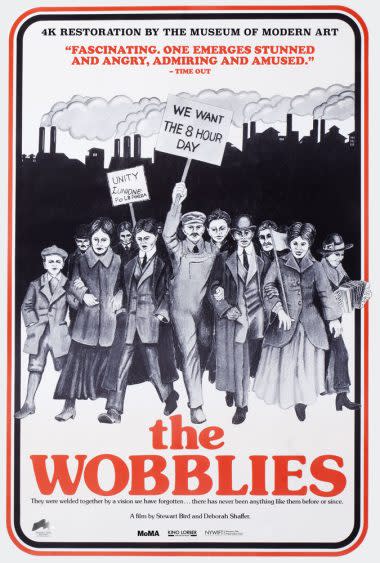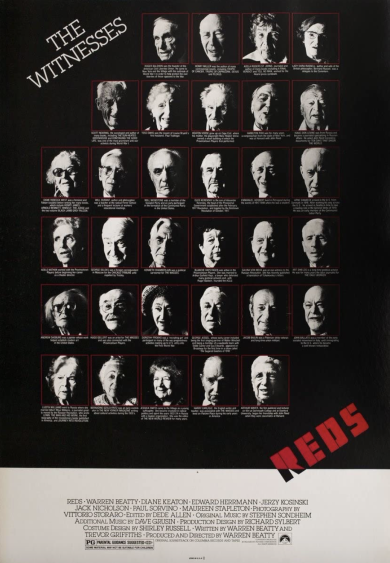1979 Union Organizing Doc ‘The Wobblies’ Re-Released, Just As Labor Movement In America Comes Back To Life

Few films released over 40 years ago can claim to be as relevant today as when they first came out. The Wobblies is one of them.
The 1979 documentary, directed by Stewart Bird and Deborah Shaffer, recounts in oral history form the story of the Industrial Workers of the World union, otherwise known as the Wobblies. The labor organization, founded in 1905, espoused the brash idea that workers should share in company profits, get medical care if they were injured on the job, and work an 8-hour day.
More from Deadline
The IWW stood apart for other reasons—it was a general union (as opposed to a craft union) that welcomed men and women, regardless of race or ethnic background. And it represented the great mass of unskilled workers, the kind of laborers who toiled in factories for long hours, for low wages, typically in dangerous conditions.

“They were opening up to everyone–anyone who earned a wage as a worker was eligible,” Bird explains. “And that was pretty radical at the time. Might be pretty radical today.”
The IWW focused on organizing miners, textile mill workers, longshoremen, loggers and agricultural laborers, among others. The union was created two years after the foundation of the Ford Motor Company, which pioneered the assembly line that turned workers into cogs in a machine.
“This was the major industrialization of the United States where there were factories and auto plants and corporations buying mines and there were time-and-motion studies and what they called ‘scientific management,’ how to speed up processes, how to make it so people worked themselves to death, basically,” Bird notes. “And there were no unions. The Wobblies put it together out of necessity.”
Kino Lorber acquired worldwide rights to the classic documentary late last year. The Wobblies, remastered by the Museum of Modern Art, is now playing in limited theatrical release, to be followed by a digital release on Kino Now and on home video. In 2021, it was inducted into the Library of Congress National Film Registry, an honor accorded only a handful of films each year.
The Wobblies was originally released the year before Ronald Reagan was elected president. One of his first acts in office was to break the Air Traffic Controllers strike, a watershed moment that augured a steep decline in union participation in the United States.
“About 17 percent of the workforce was organized in 1979,” Shaffer says. “It’s only about 9 percent now.”

AP Photo/Eduardo Munoz Alvarez
On Monday, workers at an Amazon warehouse in Staten Island, New York, rejected the chance to join a union. But a month earlier, at a much larger Amazon warehouse on Staten Island, workers stunned the company by voting to join the upstart Amazon Labor Union. And dozens of Starbucks locations have voted to unionize or petitioned for union recognition in recent months, giving hope to supporters of the union movement, as well as the filmmakers.
“Workers are not being taken care of. They’re not being valued for the contributions they make to our society,” Shaffer says. “At a certain point, they say, ‘We can’t take it anymore. We cannot continue to be pushed around like this.’ And I think we’ve reached another one of those points. It’s very exciting.”
The origins of the documentary can be traced back to a play Bird co-wrote about the IWW, first staged in the late 1970s.
“I’d become very interested in them and labor history and American history,” Bird says. “We did a play called The Wobblies: The U.S. vs. Wm. D. Haywood, et al, which played at the Hudson Guild Theatre in New York.”
Some surviving IWW organizers attended performances, witnessing a depiction of events they had participated in 50, 60 or even 70 years earlier. Shaffer, a politically active filmmaker and friend of Bird’s, also caught the show.
“There were some old Wobblies in the audience that night, and that was really the inspiration. The film was actually born that very night,” Shaffer remembers. “Because I turned to Stew afterwards, and said, ‘Listen, Stew, we have to do a film about these people…’ It just seemed so obvious to me.”
Time, however, wasn’t on the filmmakers’ side.
“We were concerned that these people were old, that it was this oral history. We had to find who was around and try to find them as quickly as we could,” Bird recalls. “We actually handed out fliers on the docks in Philadelphia [that read], ‘Was your grandpa a Wobbly?’ or something like that. The Wobblies had a union there, and there were Black workers who worked in that union… We eventually, through a church, found [Wobbly longshoreman] James Fair, who was about 90 at that time.”

Kino Lorber
Fair and other Wobblies told the filmmakers about their efforts to unionize work places in the face of stiff resistance from capitalist interests. Over a period of years, the IWW organized over 150 strikes, including walkouts at textile mills in Lawrence, Mass. in 1912 and Paterson, N.J. in 1913 and a Studebaker auto plant in 1913. In 1916 Wobblies turned out to support a strike by shingle workers in Everett, Washington, an action that turned deadly when anti-union forces opened fire on IWW members, killing as many as a dozen of them.
Wobblies knew they faced violent repercussions for their work. Part of what kept them cohesive was folk songs that were shared among union members. Those songs are woven throughout The Wobblies.
“You could recognize a fellow Wobbly on a freight train or even walking down the street if you whistled an IWW tune,” Shaffer comments. “For the foreign-born workers, the songs were a way they began to learn English, began to communicate with each other… They hadn’t maybe learned to talk the same language yet, but they could sing the same song. And I think the music created a tremendous sense of solidarity and power and joy among the workers.”

The Wobblies broke ground for its innovative use of that music. It was also innovative in its use of still photographs, and for the way the directors brought to life commentary from IWW workers and others on opposite sides of labor disputes in the early 1900s.
“Nowadays, we’re all so used to dramatic voiceovers and dramatic music and stills,” Shaffer notes, “but the way Stew and I used actors in the film to read the voices of some of the capitalists and of [union leaders] Bill Haywood and Elizabeth Gurley Flynn–that had not been done in documentaries before, I don’t believe… This is 10 years before Ken Burns’ The Civil War came out.”
One of the actors who did voiceover work on The Wobblies was future Oscar nominee Rip Torn.
“Rip Torn and Geraldine Page came to see the play The Wobblies. I almost fell down,” Bird recalls. “I was an acting student in the Village and my teacher loved Geraldine Page and they both came… And when we started realizing we needed the voices, we called Rip Torn and he agreed. ‘No problem.’”
Along with The Civil War, there’s another important film The Wobblies apparently influenced, a Best Picture Oscar nominee from 1982.

“Reds, Warren Beatty’s film,” Shaffer says, “I believe would not have [real-life] witnesses in his film if we hadn’t done The Wobblies two years before… It’s a wonderful companion to The Wobblies. And we share a couple of witnesses. [ACLU founder and former IWW member] Roger Baldwin–I’d forgotten what a big role Roger plays in Reds.”
Of perhaps greater concern to the filmmakers now is how The Wobblies might influence contemporary audiences, especially those engaged in the labor movement.
“We’re optimistic about young people. I’m very optimistic about the next generation of workers,” Shaffer says. “I’m hoping we’re at a turning point… I’m hoping that things like the Starbucks workers organizing and the Amazon workers organizing and home health aides organizing is going to really start to turn things around and some of the most exploited and most maltreated workers are going to start to get some protections and fight for their rights.”
As the Wobblies did, more than a century ago.
Best of Deadline
2022 Awards Season Calendar - Dates For The Emmys, Tonys & More
Awards Season Red Carpet Photos: Grammys, Oscars, SAG Awards & More
Spring Premiere Dates For New & Returning Series On Broadcast, Cable & Streaming
Sign up for Deadline's Newsletter. For the latest news, follow us on Facebook, Twitter, and Instagram.

